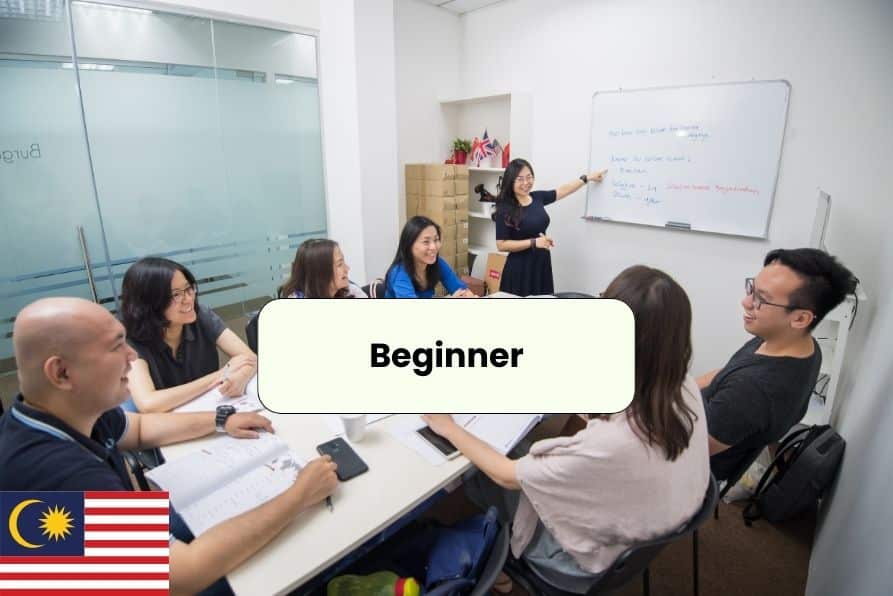Malay Language Class
Bagaimana (how)? Lingo has secret recipes!
Our formula is simple: we keep the groups small and sweet at exactly eight pax.
Many of our students are beginners looking to learn basic Malay. They love the attention and the ability to ask any question. The teacher can also slow down when they haven’t quite grasped something.
Whether you start at the basic or advanced level, you can expect to learn Malay twice as fast with us compared to other language schools in Singapore that teach in large classes.
If you come to Lingo, we start a Malay class every month. **Guaranteed** Here are a few reasons why we are popular.

Lingo is an official test centre
As an official test centre for MCYS and MFA officers, we take pride in ensuring the quality of our courses and assessments. With this expertise, we can deliver a comprehensive program that enables individuals to master the Malay language.
Small group classes
We limit group sizes to a maximum of 8 participants to ensure the quality of our M Malay classes. When classes are small enough to facilitate individual student-teacher interaction, a minor miracle occurs: teachers teach, and students learn.
Centralised location
Our Malay language classes are conducted at United House, which is centrally located and accessible. It is just a 6-minute walk from Dhoby Ghaut or Somerset MRT station.
There is a Malay class for you
Join our class, conveniently located just a 6-minute walk from both Dhoby Ghaut and Somerset MRT stations, making travel easy and hassle-free.
Group class starts at S$419.65 for 18 hours.
Learn online conveniently without the need to travel to our centre. You will receive the same attention as in an onsite class without the hassle.
Group class starts at S$380.41 for 18 hours.
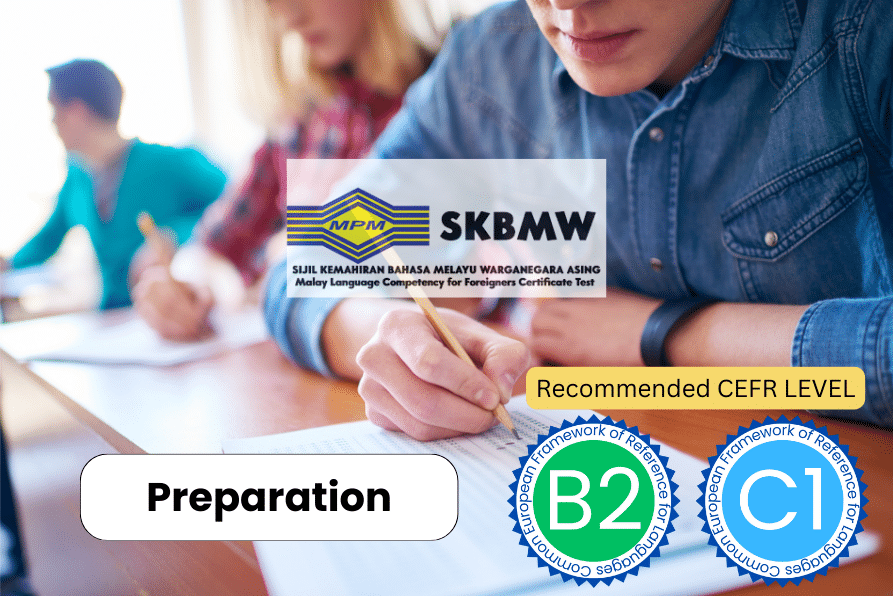
Get ready for the SKBMW exams with our intensive 20-hour courses offered in the two weeks leading up to the exam.
You can practice both the written and oral components through mock exams. Our specialised teachers will cover all aspects of the exam to ensure you’re fully prepared
Conversational Malay Class
We believe learning any language starts with basic conversation. When you’re comfortable asking basic questions and talking about oft-discussed topics such as introducing yourself, lessons become more enjoyable and you build up momentum.
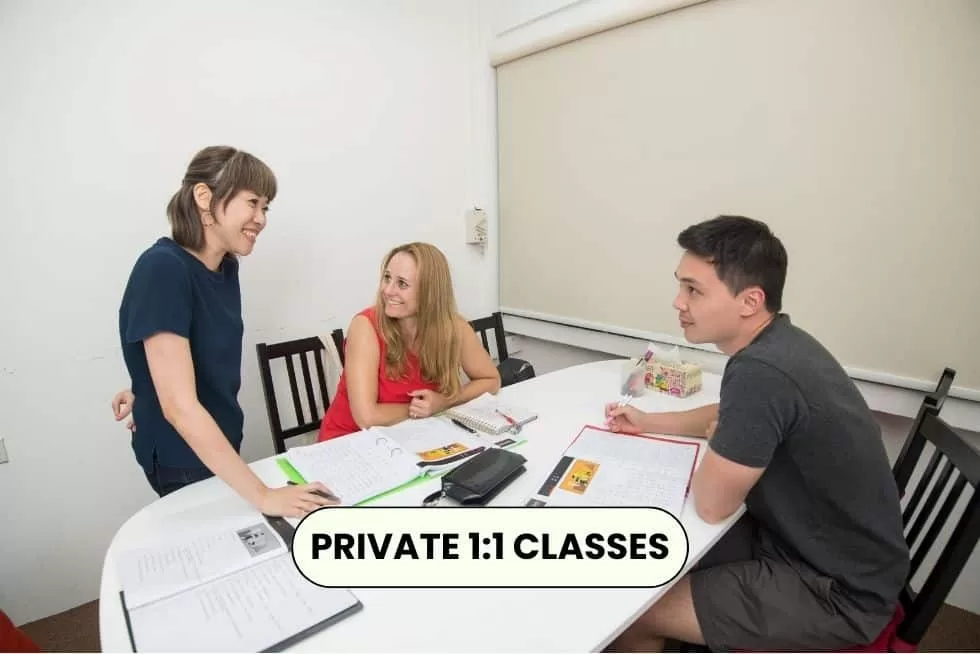
1:1 Private class
Course objective
In this course, we focus on practical aspects of the language – learning how to converse and communicate effectively in Malay.
Our proprietary textbook is developed from scratch to cater to your specific needs.
6 progressive levels

Beginner 1: $419.65
18 hours/term
Beginner 1 outline
-
Beginner 1 is structured into ten units and includes exercises (LATIHAN) for practice.
Here’s a summary of the content by unit:
- Unit 01: Numbers and Greetings (Page 4): Introduces pronunciation, numbers from 0 to 1,000,000, and basic greetings.
- Unit 02: Positive and Negative Sentences (Page 14): Covers vocabulary related to location, common verbs, and words for expressing agreement/disagreement (e.g., ya, tidak, bukan). It also explains the use of “bukan” for nominals, nouns, and pronouns.
- Unit 03: Daily Verbs (Page 22): Focuses on a variety of common verbs like “eat,” “drink,” “sleep,” “work,” “buy,” and “sell,” along with related vocabulary such as “house,” “shop,” and “market.”
- Unit 04: Question Sentence (Page 28): Teaches different question words like “what,” “how much/many,” “where,” “how,” “who,” “when,” and “why.” It also notes that adding “-kah” to question words makes the expression more polite.
- Unit 05: Family (Page 34): Introduces vocabulary for family members (e.g., grandfather, mother, siblings, in-laws) and terms related to age and marital status. It also explains forms of address (Encik, Puan, Cik) and plural forms of nouns.
- Unit 06: Occupation (Page 43): Provides vocabulary for various occupations (e.g., lecturer, teacher, doctor, manager) and related terms like “company,” “office,” and “hospital.”
- Unit 07: Numeracy (Page 49): Expands on numbers, introducing terms for ordinal numbers (first, second), fractions, quantities (few, much), and mathematical operations (plus, minus, multiply, divide). It also includes vocabulary related to price and bargaining.
- Unit 08: Time (Page 56): Covers vocabulary for date, year, month, day, week, time, and concepts like “early,” “late,” “past,” and “future.” It lists all months and days of the week.
- Unit 09: Grammar (Page 63): Explains different tenses including present, present continuous, present perfect, past, past continuous, and future.
- Unit 10: UsefulAdjectives (Page 69): Introduces adjectives such as “expensive,” “cheap,” “easy,” “difficult,” “pretty,” “ugly,” and words related to frequency (always, often, seldom).
Beginner 2 outline
-
-
- Unit 01: Verbs, Vehicles, and Places (Pages 5-9) – Introduces basic verbs, modes of transport, and common locations. Includes vocabulary, reading passages, role-playing scenarios, and exercises (translation, fill-in-the-blanks, writing, daily activities, describing pictures).
- Unit 02: Useful Words and Connecting Words (Pages 13-18) – Focuses on conjunctions and other common words to build more complex sentences. Includes vocabulary, reading, role-play (“Lunch,” “Weekend Activity”), and exercises (fill-in-the-blanks, sentence creation, role-play).
- Unit 03: Direction (Pages 19-26) – Covers vocabulary for directions and phrases for asking and giving instructions. Includes vocabulary, reading, role-play (“Go to Siti’s house,” “Take a cab,” “Lost”), and exercises (giving directions from a map, writing directions from office to home).
- Unit 04: Travel (Pages 27-35) – Introduces terms related to travel, including booking, airports, and customs. Includes vocabulary, reading, role-play (“Go to the Airport,” “Long Holiday,” “Buy Airplane Ticket”), and exercises (word translation, fill-in-the-blanks, writing a story about a holiday).
- Unit 05: Holiday (Pages 36-45) – Focuses on vocabulary for weather, seasons, and hotel facilities. Includes vocabulary, reading, role-play (“Sunny Day,” “In the hotel,” “Hotel reservation”), and exercises (answering questions about seasons, fill-in-the-blanks, sentence creation about holidays).
- Unit 06: Dining (Pages 46-54) – Covers vocabulary for dining, ordering food, and party invitations. Includes vocabulary, reading, role-play (“Dinner at Restaurant,” “Wedding ceremony,” “Birthday party invitation”), and exercises (fill-in-the-blanks, creating a food ordering scenario).
- Unit 07: Feelings and New Places (Pages 55-62) – Introduces words to express emotions and describe different types of places. Includes vocabulary, reading, role-play (“Moved House,” “Change Job”), and exercises (matching feelings to pictures, sentence translation, sharing experiences of a first job).
- Unit 08: Working in Office (Pages 63-71) – Focuses on terms related to office work, business, and meetings. Includes vocabulary, reading, role-play (“Busy,” “Meeting Schedule,” “Important Meeting”), and exercises (word translation, sentence creation, listing daily office sentences).
- Unit 09: Health and Body Parts (Pages 72-81) – Covers vocabulary for body parts, common illnesses, symptoms, and medical terms. Includes vocabulary, reading, role-play (“Why Hafiz did not come to school?,” “Go to Hospital”), and exercises (fill-in-the-blanks, matching words, matching body parts/actions).
- Unit 10: Dating (Pages 82-88) – Introduces vocabulary and phrases related to dating and relationships. Includes vocabulary, reading, role-play (“What is your hobby?,” “Ask for a date”), and exercises (fill-in-the-blanks for a story, translating a story).
-

Fees: S$419.65
18 hours/term
Pre-Intermediate 1 outline
In Bahasa Melayu, many nouns are formed from the root words of verbs or adjectives. This transformation is achieved by adding specific prefixes or suffixes, which change the word’s grammatical category while maintaining its core meaning. For example, the verb “tulis” (to write) can be converted into the noun “tulisan” (writing) through the addition of the suffix.
Where learn Pre-Intermediate?
Unlike English, where word forms can vary significantly, Bahasa Melayu relies heavily on these root words and their derivatives. Therefore, understanding how prefixes and suffixes function is crucial for mastering the language, as it allows speakers and learners to expand their vocabulary and comprehend the nuances of meaning effectively. This morphological aspect of Bahasa Melayu highlights its logical structure and the interconnectedness of its lexicon.
-
- Unit 1 – Suffix “-an”
- Unit 2 – Prefix “me-”
- Unit 3 – Prefix “di-”
- Unit 4 – Suffix “kan”
- Unit 5 – Prefix “ber-”
- Unit 6 – Prefix “pe-”
Pre-Intermediate 2 outline
In this level, we explore the concept of circumfixes, which serve to provide a deeper understanding of an action associated with a root word. Additionally, we will delve into the construction of both active and passive sentences that emerge from transitive verbs, enhancing our grasp of their grammatical functions and implications.
- Unit 1 – Prefix “ter-“
- Unit 2 – Circumfix “me-kan”
- Unit 3 – Circumfix “di-kan”
- Unit 4 – Circumfix “me-i”
- Unit 5 – Circumfix “di-i”
- Unit 6 – Circumfix “ber-an”
Pre-Intermediate 3 outline
This level delves into the rich exploration of adverbs, nouns, and abstract nouns, aiming to deepen learners’ appreciation for more sophisticated vocabulary. By mastering these essential parts of speech, students will equip themselves with the tools to navigate the intricacies of challenging words with greater ease. This approach not only enhances their understanding of grammar rules but also allows them to draw connections to vocabulary, uncovering meanings rooted in words themselves. As a result, learners gain the confidence to engage with the language more profoundly. The complexity of this vocabulary is often found within the pages of news articles and textbooks, seamlessly relating to the nuances of daily life and communication.
- Unit 1 – Yang & Suffix “-nya”
- Unit 2 – Prefix “se-“
- Unit 3 – Circumfix “se-nya”
- Unit 4 – Circumfix “ke-an”
- Unit 5 – Circumfix “pe-an”
- Unit 6 – Circumfix “per-an”

Fees: S$419.65/term
18 hours/term
Intermediate 1 outline
Armed with a solid understanding of prefixes, suffixes, and circumfixes, students are now poised to launch into an enriching reading and writing program. This crucial knowledge will deepen their mastery of the Malay language, allowing them to fluidly transition between street Malay and formal Malay with confidence.
Moreover, they will gain the essential skills needed to effectively utilise formal Malay in letters and presentations, setting them up for success in both academic and professional contexts.
Which course is for you?
Beginners, please choose A1.1.
New students with some Malay knowledge: Please get in touch with us via the “Course placement” form
Other information
- In every level, you will need to purchase a textbook at S$59.95
- We will issue a certificate upon completion of the course, provided you have achieved 80% attendance.
- Our classes are hybrid, so you can attend either online or in person. If you sign up, we will assume you will attend in person. Please let us know if you decide to switch to online.
Course objective
| Course Name | Start Date | Day | Time | Duration | Fee | Enrol |
|---|---|---|---|---|---|---|
| Bahasa Melayu Pre-Intermediate 2 (ONLINE) | 15 Nov 2025 | Saturday | 11:30 am - 1:30 pm | 9 weeks | S$419.65 | Enrol |
| Bahasa Melayu Beginner 1 (ONLINE) | 22 Nov 2025 | Saturday | 11:30 am - 1:00 pm | 12 weeks | S$419.65 | Enrol |
| Bahasa Melayu Beginner 1 (ONLINE/ONSITE) | 03 Dec 2025 | Wednesday | 8:00 pm - 9:30 pm | 12 weeks | S$419.65 | Enrol |
| Bahasa Melayu Beginner 1 (ONSITE) | 04 Dec 2025 | Thursday | 6:30 pm - 8:00 pm | 12 weeks | S$419.65 | Enrol |
| Bahasa Melayu Beginner 2 (ONLINE) | 11 Dec 2025 | Thursday | 8:00 pm - 9:30 pm | 12 weeks | S$419.65 | Enrol |
| Bahasa Melayu Beginner 1 (ONLINE/ONSITE) | 18 Dec 2025 | Thursday | 6:30 pm - 8:00 pm | 12 weeks | S$419.65 | Enrol |
| Bahasa Melayu Beginner 1 (ONSITE/ONLINE) | 20 Dec 2025 | Saturday | 11:30 am - 1:00 pm | 12 weeks | S$419.65 | Enrol |
| Bahasa Melayu Beginner 1 (ONSITE/ONLINE) | 03 Jan 2026 | Saturday | 11:30 am - 1:00 pm | 12 weeks | S$419.65 | Enrol |
| Bahasa Melayu Beginner 1 (ONLINE/ONSITE) | 08 Jan 2026 | Thursday | 6:30 pm - 8:00 pm | 12 weeks | S$419.65 | Enrol |
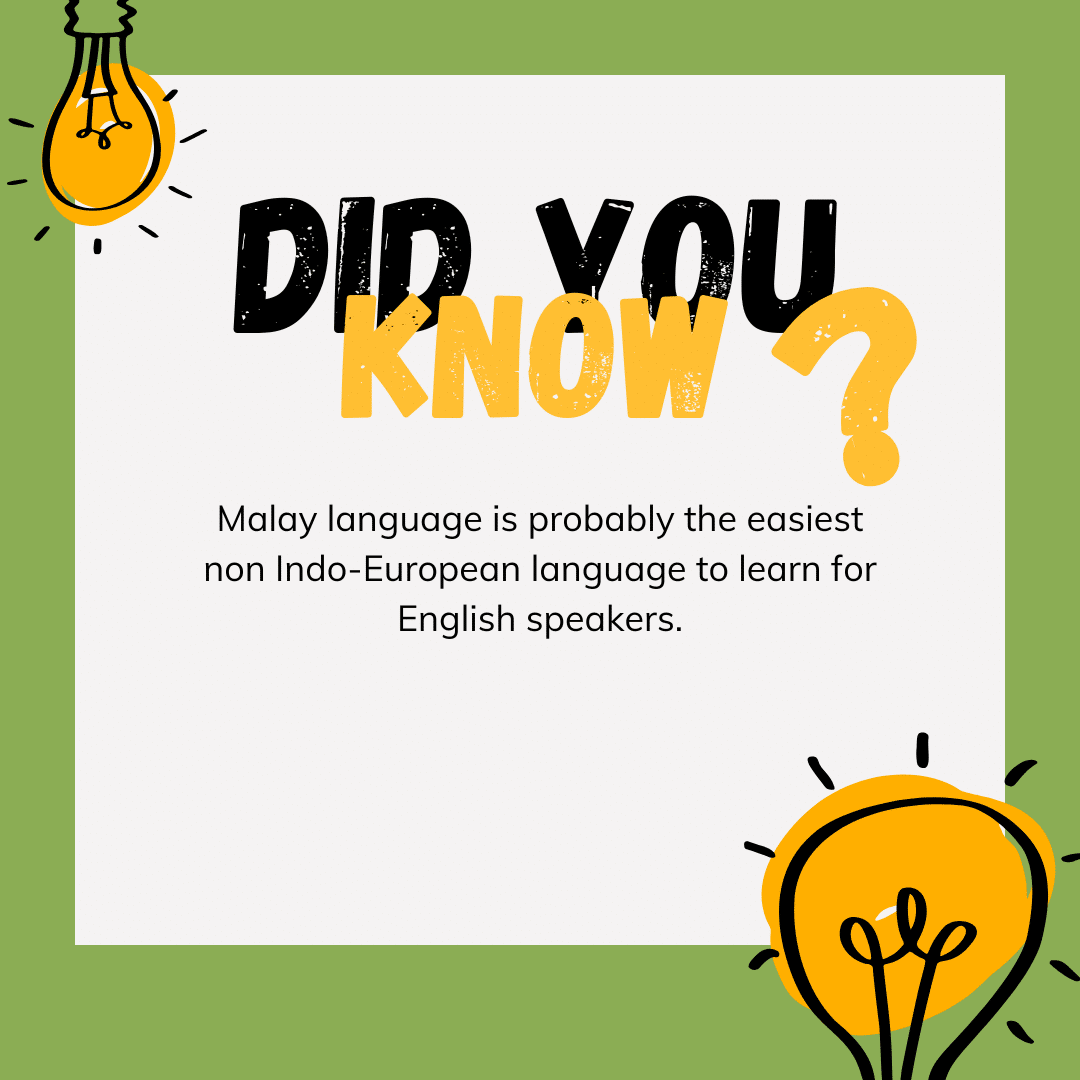
Ini senang... Lah
Malay has no article (ie the, a or an). The user simply drops the article or replaces the use of the article with this/these/that. For example, The Sun rises from the East. Matahari (sun) terbit (rise) dari (from) timur (east).
There are no verb tenses in Malay. The user indicates the time of the action or uses the word ‘sudah’ (already) or ‘akan’ (will be) to indicate the action happened in the past or future.
Malay has no noun gender.
The Malay language has no pleural form. The pleural forms are indicated by adjectives like few/some/many before the noun. Sometimes, the pleural form is expressed simply by repeating the noun. For example, anak (child) becomes anak-anak (children).
There is no noun cases. ‘Saya’ can mean I, me, my or mine. ‘Dia’ can mean he, she, his, her, him, hers.
Learn Malay with our proprietary material
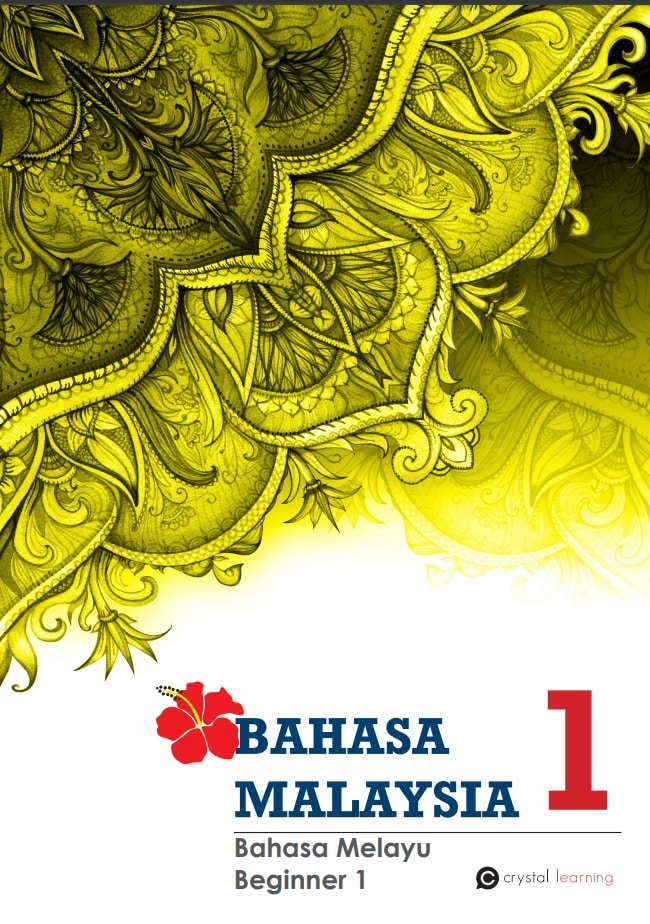
Awards and Accolades

Rated best Malay language class in Singapore


Do you have a question?
Ask me any question and I will respond in mins, if I can’t answer your question, don’t worry there is a human who will respond to you in a few hours.
Malay language FAQ
Can I get a refund if the class doesn’t start?
Can I get a refund if I do not like the class?
Once the class has started, no refunds will be allowed for whatever reason at all.
Can I change trainer or class if my schedule does not allow me to attend anymore or I do not like the trainer?
Do you have free trial classes?
No, we currently don’t offer trial classes for Malay language programme.
I am not a beginner, which class should I join?
We offer courses at various levels, all the way from total beginners through intermediate to advanced level (A1, A2, B1, B2 and C1). Please contact us and we help you to determine the level that is most suitable for you
I am a complete beginner
That’s perfect! Don’t worry, we offer courses on various levels, all the way from total beginners through intermediate to advanced level (A1, A2, B1, B2 and C1)
To view the schedule for the Beginner class, please click the link below.
I'm looking for a beginner class for my son /daughter / child
Thank you for letting me know that you are looking for a course for your child. It is beneficial to start learning from a young age, and in fact, children tend to absorb knowledge more quickly than adults. For some languages, we offer specific teenager classes, and depending on the age of your child, they can also join an adult class. Please contact us so we can work out the best solution for your child.
What is the schedule like?
Click on this link to find out our Malay class schedule:
How much does it cost?
Our Malay class fees are consistent across all levels. The fee for online classes is S$380.41, while onsite classes cost S$419.65 for A1.1. These fees include materials and GST.
For our class schedule and fees, please visit our beginner information page on Bahasa Melayu Beginner 1: www.lingo.edu.sg/malay/#class
Do I get a certificate after completing the course?
Yes. Your e-certificate will automatically be emailed to you upon completing the course. If you prefer a hardcopy one, we are happy to prepare it for you at $5 each plus GST.
Is your certificate officially recognised?
Can I use a CEFR certificate to apply for a certain job?
CEFR is NOT an academic certificate. It is to benchmark your proficiency in a particular language. It definitely helps you to prove that you have a certain degree of proficiency and might or might not help you in your job application, depending on the company’s requirements.
Can I join a different class if I missed a lesson?
To maintain the original class size, we do not permit class switching for makeup classes.
If you miss a class, you have three options:
Option 1: Purchase a set of class recordings for $54.50 (covering the full course).
Option 2: Schedule a one-on-one make-up class with the Malay language trainer for $43.6 for a one-hour session.
Option 3: Choose to engage in self-study. Please note that to ensure the quality of learning, you are only allowed to miss two classes to progress to the next term. A maximum of two make-up classes is permitted, and recordings do not count as attendance.
Are there any exams?
What is a CEFR examination?
How do I register for your Malay classes?
How do I pay?
We accept credit cards and paynow. Just click on the enrol button and you will be directed to the payment page.
www.lingo.edu.sg/malay/#class
Malay language FAQ
Can I get a refund if the class doesn’t start?
Sure! If we do not have enough students enrolled in the class you have signed up for, we will contact you and ask if you would like to join a different class on an alternative schedule. If you do not wish to proceed, we will refund the full amount you have paid. Please note that refunds can only be credited back via the same method used for payment and will be processed early in the following month. Once the class has started, though, a refund will not be possible any more.
Can I get a refund if I do not like the class?
Once the class has started, no refunds will be allowed for whatever reason at all.
Can I change trainer or class if my schedule does not allow me to attend anymore or I do not like the trainer?
Can I join a different class if I missed a lesson?
To maintain the original class size, we do not allow class switching for a makeup class. If you join a hybrid group class, instead, you can consider purchasing the zoom recordings at $50, which are also great for revisions or you can request a private 1 to 1 makeup class with your teacher at $65 per hour plus GST for Thai, Spanish, French, German, and $50 plus GST for (Mandarin, Japanese, Cantonese, Tamil, Hindi, Tagalog, Vietnamese, Malay, Indonesia, Burmese).
Do you have free trial classes?
To maintain the original class size, we do not permit class switching for makeup classes.
If you miss a class, you have three options:
Option 1: Request the Zoom recording from our admin for a fee of $50 (before GST).
Option 2: Schedule a one-on-one make-up class with the Malay language trainer for $40 (before GST) for a one-hour session.
Option 3: Choose to engage in self-study. Please note that to ensure the quality of learning, you are only allowed to miss two classes to progress to the next term. A maximum of two make-up classes is permitted, and recordings do not count as attendance.
I am not a beginner, which class should I join?
We offer courses at various levels, all the way from total beginners through intermediate to advanced level (A1, A2, B1, B2 and C1). Please contact us and we help you to determine the level that is most suitable for you
I am a complete beginner
That’s perfect! Don’t worry, we offer courses on various levels, all the way from total beginners through intermediate to advanced level (A1, A2, B1, B2 and C1)
I'm looking for a beginner class for my son /daughter / child
Thank you for letting me know that you are looking for a course for your child. It is beneficial to start learning from a young age, and in fact, children tend to absorb knowledge more quickly than adults. For some languages, we offer specific teenager classes, and depending on the age of your child, they can also join an adult class. Please contact us so we can work out the best solution for your child.
What is the schedule like?
That’s an important question indeed. The schedule and start time for a class of course vary from time to time. Please go to the language that you want to learn; the schedule and cost are published there. Otherwise, for future schedules, please contact us.
How much does it cost?
Do I get a certificate after completing the course?
Yes. Your e-certificate will automatically be emailed to you upon completing the course. If you prefer a hardcopy one, we are happy to prepare it for you at $5 each plus GST.
Is your certificate officially recognised?
Our certificates are in-house certificates to show that you have completed a certain level in our centre, but is NOT an official certificate recognised as an academic certificate
Can I use a CEFR certificate to apply for a certain job?
CEFR is NOT an academic certificate. It is to benchmark your proficiency in a particular language. It definitely helps you to prove that you have a certain degree of proficiency and might or might not help you in your job application, depending on the company’s requirements.
Are there any exams?
Examinations are not mandatory and are conducted independently of the course. Should you require an examination or test, please contact us to arrange a suitable date and time. A fee of SGD200 plus GST applies for each 2-hour examination session.
What is a CEFR examination?
CEFR is NOT an official examination. It is to benchmark your proficiency based on the European Language Framework. This exam can be done in our centre. Please take note that different centres have different methods of assessing your proficiency, as there is no specific guideline on how to conduct such examinations. The CEFR is used in Lingo to gauge or benchmark proficiency. Still, it is not an official examination recognised by the Ministry of Education (MOE) or other authorities.



